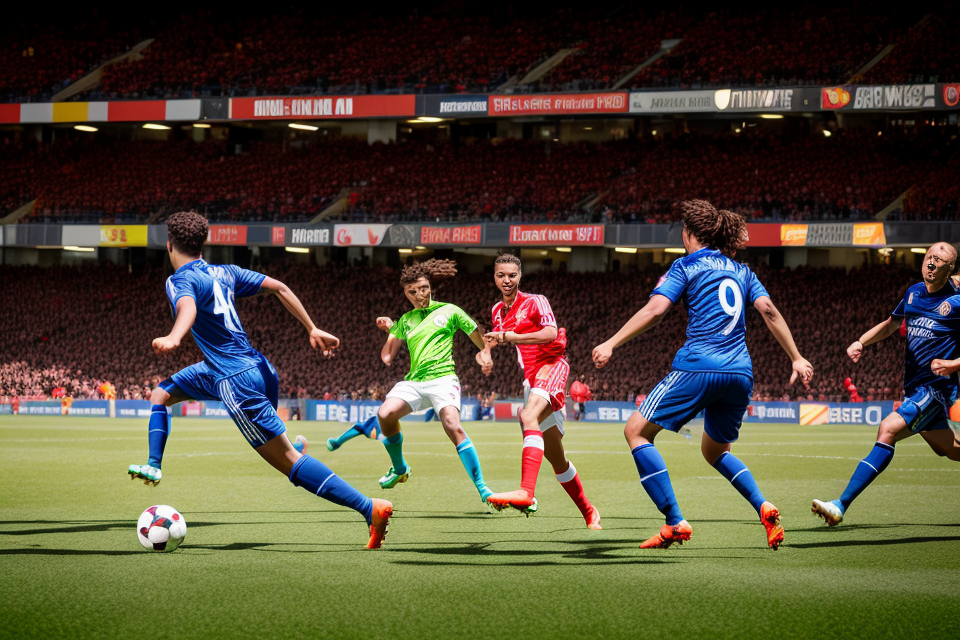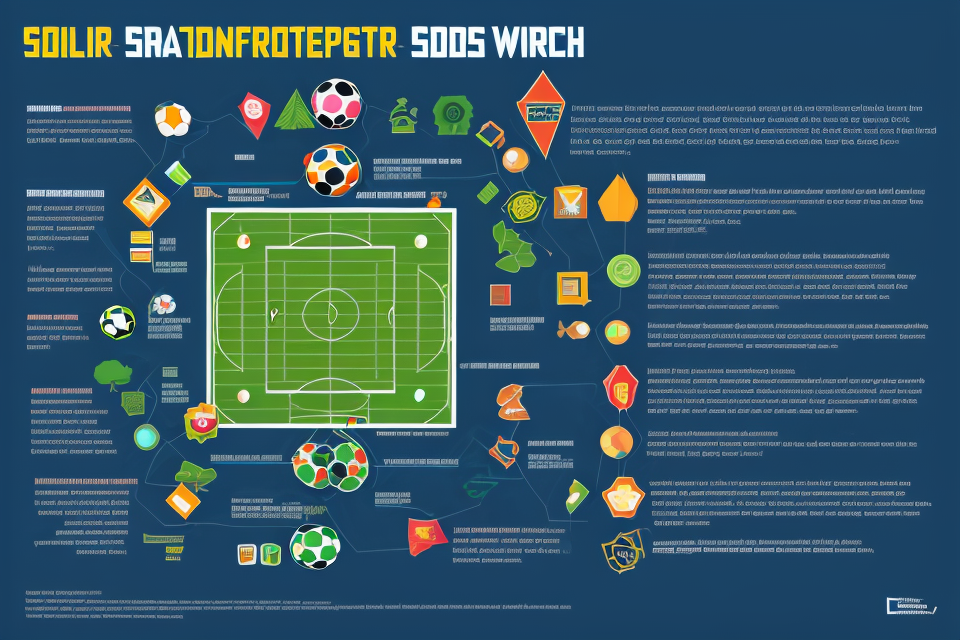Soccer is a game of strategy, where every move on the field is carefully planned and executed. From the way players position themselves to the tactics they use to outmaneuver their opponents, strategy is at the heart of the game. In this comprehensive guide, we will explore the role of strategy in soccer and how it can make or break a team’s success. Whether you’re a seasoned player or a soccer enthusiast, this guide will give you a deeper understanding of the game and the importance of strategy in achieving victory. So, let’s get started and discover the secrets of successful soccer strategies!
What is a Strategy in Soccer?
Defining Strategy in Soccer
In soccer, a strategy refers to a plan of action that a team or coach adopts in order to achieve a specific goal or set of goals. A well-defined strategy in soccer should take into account the strengths and weaknesses of the team, the opposition, and the specific circumstances of the match.
A successful soccer strategy should include the following key components:
- Formation: The tactical arrangement of players on the field, including the positions of the defenders, midfielders, and forwards.
- Tactics: The specific techniques and moves used by the team to outmaneuver the opposition and create scoring opportunities.
- Fitness and conditioning: The physical preparation of the players, including their endurance, strength, and agility, which are essential for executing the strategy effectively.
- Mental preparation: The psychological approach of the team, including their motivation, focus, and resilience, which are crucial for overcoming adversity and maintaining a positive mindset.
A well-defined strategy is essential for success in soccer, as it provides a clear framework for the team to follow and helps them to stay focused and organized throughout the match. A poorly defined strategy, on the other hand, can lead to confusion, disorganization, and ultimately, defeat.
Types of Strategies in Soccer
Soccer is a game that requires a great deal of strategy in order to be successful. There are three main types of strategies in soccer: offensive strategies, defensive strategies, and transition strategies.
Offensive Strategies
Offensive strategies are used by a team when they are trying to score a goal. Some common offensive strategies include:
- Building attacks from the back: This strategy involves the goalkeeper and defenders playing the ball out from the back, using short passes to move the ball up the field.
- Wing play: This strategy involves the wide midfielders or fullbacks making runs down the sideline and crossing the ball into the box.
- Through balls: This strategy involves a player making a run through the opposition’s defense, with a teammate playing a long ball over the top for them to run onto.
- Quick counter-attacks: This strategy involves the team quickly transitioning from defense to offense, taking advantage of the opposition’s mistakes.
Defensive Strategies
Defensive strategies are used by a team when they are trying to prevent the opposition from scoring. Some common defensive strategies include:
- Man-marking: This strategy involves each defender being assigned to mark a specific opposition player, with the aim of preventing them from getting the ball.
- Zonal marking: This strategy involves defenders being assigned to specific areas of the field, rather than specific opposition players.
- Blocking crosses: This strategy involves defenders positioning themselves to block the opposition’s crosses into the box.
- Pushing up: This strategy involves the defenders pushing up the field to put pressure on the opposition, making it harder for them to build attacks.
Transition Strategies
Transition strategies are used by a team when they are switching from offense to defense, or vice versa. Some common transition strategies include:
- Counter-pressing: This strategy involves the team quickly transitioning from defense to offense, pressing the opposition high up the field and trying to win the ball back as soon as possible.
- Defensive transitions: This strategy involves the team quickly transitioning from offense to defense, dropping back into their own half and setting up a defensive shape.
- Aerial duels: This strategy involves the team winning balls in the air, either through headers or by challenging for balls that have been cleared.
- Quick switches of play: This strategy involves the team quickly switching the play from one side of the field to the other, catching the opposition off guard.
Key Elements of a Successful Soccer Strategy
Team Formation and Tactics
Choosing the right formation for your team
- The importance of selecting a formation that complements your team’s strengths and weaknesses
- Examining common formations such as 4-4-2, 3-5-2, and 4-3-3
- The role of the team’s style of play in determining the optimal formation
Implementing effective tactics on the field
- The significance of developing a game plan tailored to specific opponents
- Strategies for controlling possession, maintaining pressure, and exploiting weaknesses
- The role of set pieces and counter-attacks in executing successful tactics
Overall, choosing the right formation and implementing effective tactics are crucial elements of a successful soccer strategy. By carefully considering team strengths and weaknesses, as well as the style of play and opposition, coaches can develop a game plan that maximizes their team’s potential on the field.
Player Roles and Responsibilities
When it comes to developing a successful soccer strategy, one of the most important aspects is identifying the key players and their roles within the team. This involves understanding the strengths and weaknesses of each player, as well as their position on the field.
Assigning responsibilities to players is equally important. This means determining what each player’s role will be during the game, whether it’s to defend, attack, or both. By assigning specific responsibilities to each player, the team can work together more effectively and achieve their goals on the field.
To effectively identify key players and their roles, coaches should consider factors such as a player’s skill set, physical abilities, and mental toughness. They should also consider the player’s past performance and their ability to work well with other team members.
Once the key players have been identified, coaches can begin to assign specific responsibilities to each player. This may involve determining which players will be responsible for defending, which players will be responsible for attacking, and how the team will transition between defense and offense.
In addition to assigning specific responsibilities, coaches should also consider how to best utilize each player’s strengths. For example, a player with excellent ball control skills may be best suited for a more attacking role, while a player with strong defensive skills may be better suited for a more defensive position.
By understanding the role of each player within the team, coaches can develop a more effective soccer strategy that will help the team achieve their goals on the field. This may involve making changes to the team’s formation, adjusting the team’s tactics, or even making changes to the team’s training regimen.
Ultimately, the success of a soccer team depends on the ability of the coach to effectively identify key players and their roles, as well as to assign specific responsibilities to each player. By doing so, the team can work together more effectively and achieve their goals on the field.
Fitness and Conditioning
Ensuring players are physically fit and prepared
A successful soccer strategy requires players who are physically fit and prepared to perform at their best. This means that coaches must prioritize fitness and conditioning in their training programs. To achieve this, coaches should consider the following:
- Incorporating a variety of training methods, including cardiovascular exercises, strength training, and flexibility exercises.
- Tailoring training programs to meet the needs of individual players, taking into account their fitness levels, position, and playing style.
- Encouraging players to maintain a healthy diet and lifestyle outside of training to support their physical development.
Incorporating conditioning exercises into training
In addition to prioritizing overall fitness, coaches should also incorporate conditioning exercises into their training programs. These exercises should be specific to the demands of soccer and should aim to improve players’ endurance, speed, agility, and power. Some examples of conditioning exercises that can be used in soccer training include:
- Interval training, such as sprint intervals or interval hill sprints, which can improve players’ endurance and cardiovascular fitness.
- Plyometrics, such as jump squats or box jumps, which can improve players’ power and explosiveness.
- Agility drills, such as ladder drills or cone drills, which can improve players’ agility and coordination.
By incorporating these conditioning exercises into training, coaches can help players develop the physical attributes necessary to succeed on the soccer field.
Game Analysis and Scouting
- Analyzing opponents and their strengths and weaknesses
- Conducting research on opposing teams and players
- Identifying patterns in their play style and tendencies
- Determining areas of vulnerability
- Scouting players and teams before games
- Observing opponents in person or through video footage
- Gathering information on individual players’ skills and tendencies
- Assessing the overall strengths and weaknesses of the opposing team
In soccer, having a thorough understanding of one’s opponents is crucial for developing an effective strategy. Game analysis and scouting are two key components of this process.
Firstly, analyzing opponents involves researching their strengths and weaknesses, patterns in their play style, and areas of vulnerability. This can be done through a variety of methods, including studying previous games, analyzing statistics, and consulting with scouts who have observed the opposing team in person.
Secondly, scouting involves gathering information on the opposing team and individual players before the game. This can be done through various means, such as watching video footage of their games, observing them in person, or consulting with scouts who have extensive knowledge of the team.
By conducting thorough game analysis and scouting, soccer teams can gain valuable insights into their opponents’ play style and tendencies, which can be used to develop a strategy that exploits their weaknesses and capitalizes on their strengths.
Adapting to Game Situations
Adapting to game situations is a crucial aspect of a successful soccer strategy. It involves making in-game adjustments based on changing circumstances and reacting to the opponent’s tactics and moves. This requires a high level of flexibility and quick decision-making abilities from the players and the coaching staff.
Some of the key aspects of adapting to game situations include:
- Identifying and exploiting weaknesses: A team that can quickly identify and exploit the weaknesses of their opponents is likely to have a significant advantage. This requires a deep understanding of the opponent’s tactics, strengths, and weaknesses.
- Making tactical changes: In many cases, a team may need to make tactical changes in response to the opponent’s tactics. For example, if the opponent is using a particularly effective formation, the team may need to adjust their own formation or tactics to counter it.
- Managing player fatigue: As the game progresses, player fatigue can become a significant factor. A team that can effectively manage player fatigue and make substitutions at the right time is likely to have a significant advantage.
- Making the most of set pieces: Set pieces, such as corner kicks and free kicks, can be an important source of goals. A team that can effectively execute set pieces is likely to have a significant advantage.
- Managing emotions: Soccer is an emotional sport, and it can be difficult to maintain a level head during high-pressure situations. A team that can effectively manage their emotions and stay focused on the task at hand is likely to have a significant advantage.
In summary, adapting to game situations is a critical aspect of a successful soccer strategy. It requires a high level of flexibility, quick decision-making abilities, and a deep understanding of the opponent’s tactics, strengths, and weaknesses. By effectively identifying and exploiting weaknesses, making tactical changes, managing player fatigue, making the most of set pieces, and managing emotions, a team can gain a significant advantage over their opponents.
Developing a Winning Soccer Strategy
Assessing Your Team’s Strengths and Weaknesses
When developing a winning soccer strategy, it is crucial to assess your team’s strengths and weaknesses. This involves identifying areas of improvement and building on existing strengths. Here are some steps to follow:
Identifying Areas of Improvement
The first step in assessing your team’s strengths and weaknesses is to identify areas of improvement. This can be done by analyzing past games and performances, as well as conducting training sessions and practices to observe how the team operates. Some areas to focus on may include:
- Passing accuracy and timing
- Ball control and possession
- Defensive positioning and marking
- Attacking strategies and goal-scoring opportunities
By identifying areas of improvement, you can create a plan to address these weaknesses and improve the team’s overall performance.
Building on Existing Strengths
In addition to identifying areas of improvement, it is also important to build on existing strengths. This can involve incorporating plays or tactics that the team has already shown to be effective, as well as focusing on individual players’ strengths and utilizing them in key positions.
Some examples of building on existing strengths may include:
- Playing to a dominant striker’s strengths by providing them with a high volume of goal-scoring opportunities
- Utilizing a midfielder’s passing ability to control the game and create scoring chances
- Incorporating a defender’s physical presence and ability to win aerial battles to defend set pieces
By building on existing strengths, you can create a winning soccer strategy that maximizes the team’s potential and helps them achieve success on the field.
Setting Goals and Objectives
Establishing clear objectives for the team is an essential part of developing a winning soccer strategy. This involves setting realistic and achievable goals that align with the team’s overall vision and mission. By setting specific and measurable goals, the team can stay focused and motivated throughout the season.
Some key considerations when setting goals and objectives for the team include:
- Identifying the team’s strengths and weaknesses
- Analyzing the competition and their strengths and weaknesses
- Considering the team’s available resources, including budget, personnel, and facilities
- Establishing a timeline for achieving the goals and objectives
Once the goals and objectives have been established, it is important to communicate them clearly to all members of the team. This includes the coaches, players, and support staff. By ensuring that everyone is on the same page, the team can work together towards achieving the goals and objectives.
In addition to setting team-level goals and objectives, it is also important to set individual player goals and objectives. This helps to ensure that each player is working towards their own personal development and growth, as well as contributing to the team’s overall success.
Overall, setting clear goals and objectives is a crucial part of developing a winning soccer strategy. It helps to ensure that the team is focused, motivated, and working towards a common goal.
Implementing the Strategy
Effective implementation of a soccer strategy is crucial for success on the field. The following are some key aspects of implementing a winning soccer strategy:
Communicating the Strategy to Players
Communication is key in any team sport, and soccer is no exception. The coach or manager must clearly communicate the strategy to the players, ensuring that they understand their roles and responsibilities within the team. This can be achieved through team meetings, individual player consultations, and video analysis of games.
Providing Clear Instructions and Expectations
Once the strategy has been communicated, it is important to provide clear instructions and expectations to the players. This includes outlining the specific tactics and techniques that will be used, as well as the expected level of performance from each player. The coach or manager should also provide feedback and support to the players, helping them to understand how they can improve their performance and contribute to the team’s success.
Additionally, it is important to monitor the progress of the team and make adjustments to the strategy as necessary. This may involve changing tactics in response to the opposition’s strengths and weaknesses, or adapting the strategy to account for changes in player availability or form. The coach or manager must be flexible and responsive, making decisions based on the team’s performance on the field.
Overall, implementing a winning soccer strategy requires effective communication, clear instructions, and a willingness to adapt and evolve as the team progresses. By following these guidelines, coaches and managers can help their teams to achieve success on the field and reach their full potential.
Evaluating and Adjusting the Strategy
Evaluating and adjusting the strategy is a crucial aspect of developing a winning soccer strategy. This involves monitoring the team’s progress and making necessary adjustments to the strategy based on their performance.
Monitoring the Team’s Progress
Monitoring the team’s progress is essential to evaluate the effectiveness of the strategy. This can be done by analyzing various metrics such as possession, passes completed, shots on target, and goals scored. These metrics can provide valuable insights into the team’s performance and help identify areas that need improvement.
Making Necessary Adjustments to the Strategy
Based on the team’s performance, adjustments to the strategy may be necessary. For example, if the team is struggling to maintain possession, the coach may decide to modify the passing strategy to focus on shorter, simpler passes. Similarly, if the team is not creating enough scoring opportunities, the coach may decide to adjust the attacking strategy to focus on more direct plays.
It is important to note that adjustments should be made based on the team’s performance, not personal preferences or biases. The coach should remain objective and make data-driven decisions to ensure the team’s success.
In addition, it is important to communicate any changes to the players to ensure they are aware of the adjustments and can implement them effectively during the game. This can be done through team meetings, training sessions, and individual feedback.
Overall, evaluating and adjusting the strategy is a critical aspect of developing a winning soccer strategy. By monitoring the team’s progress and making necessary adjustments based on their performance, coaches can optimize their team’s performance and increase their chances of success.
FAQs
1. What is a strategy in soccer?
A strategy in soccer refers to a planned approach or game plan that a team or coach implements during a match to achieve a specific goal or objective. It involves making tactical decisions about how to position players on the field, how to move the ball up the pitch, and how to defend against the opposition.
2. Why is strategy important in soccer?
Strategy is important in soccer because it helps teams to be more effective and efficient on the field. It allows players to anticipate what their opponents will do and to make decisions based on that information. A well-designed strategy can also help teams to minimize mistakes and make the most of their strengths.
3. What are some common soccer strategies?
There are many different soccer strategies that teams may use, depending on their strengths and weaknesses, as well as the strengths and weaknesses of their opponents. Some common strategies include parking the bus (defending deeply with all players behind the ball), pressing (aggressively pursuing the ball when the opposition has it), and tiki-taka (short passing between players to keep possession).
4. How do coaches develop soccer strategies?
Coaches typically develop soccer strategies by analyzing their own team’s strengths and weaknesses, as well as those of their opponents. They may also consider factors such as the size and condition of the pitch, the weather, and the physical and mental state of the players. Coaches may also study game footage and statistics to identify patterns and trends that can inform their strategy.
5. How do players execute a soccer strategy?
Players execute a soccer strategy by following the instructions of their coach and working together as a team. This may involve making specific runs or movements off the ball, positioning themselves in certain areas of the field, or pressing or defending in a certain way. Players must also be aware of their teammates’ movements and be able to adjust their own play accordingly.
6. Can a strategy guarantee success in soccer?
No strategy can guarantee success in soccer, as there are many factors that can influence the outcome of a match, such as the skill and talent of the players, the condition of the pitch, and the weather. However, a well-designed strategy can improve a team’s chances of success by helping them to make more effective decisions on the field and to exploit the weaknesses of their opponents.



